Xiao Han
HUMOF: Human Motion Forecasting in Interactive Social Scenes
Jun 05, 2025Abstract:Complex scenes present significant challenges for predicting human behaviour due to the abundance of interaction information, such as human-human and humanenvironment interactions. These factors complicate the analysis and understanding of human behaviour, thereby increasing the uncertainty in forecasting human motions. Existing motion prediction methods thus struggle in these complex scenarios. In this paper, we propose an effective method for human motion forecasting in interactive scenes. To achieve a comprehensive representation of interactions, we design a hierarchical interaction feature representation so that high-level features capture the overall context of the interactions, while low-level features focus on fine-grained details. Besides, we propose a coarse-to-fine interaction reasoning module that leverages both spatial and frequency perspectives to efficiently utilize hierarchical features, thereby enhancing the accuracy of motion predictions. Our method achieves state-of-the-art performance across four public datasets. Code will be released when this paper is published.
Learning Generalized and Flexible Trajectory Models from Omni-Semantic Supervision
May 23, 2025Abstract:The widespread adoption of mobile devices and data collection technologies has led to an exponential increase in trajectory data, presenting significant challenges in spatio-temporal data mining, particularly for efficient and accurate trajectory retrieval. However, existing methods for trajectory retrieval face notable limitations, including inefficiencies in large-scale data, lack of support for condition-based queries, and reliance on trajectory similarity measures. To address the above challenges, we propose OmniTraj, a generalized and flexible omni-semantic trajectory retrieval framework that integrates four complementary modalities or semantics -- raw trajectories, topology, road segments, and regions -- into a unified system. Unlike traditional approaches that are limited to computing and processing trajectories as a single modality, OmniTraj designs dedicated encoders for each modality, which are embedded and fused into a shared representation space. This design enables OmniTraj to support accurate and flexible queries based on any individual modality or combination thereof, overcoming the rigidity of traditional similarity-based methods. Extensive experiments on two real-world datasets demonstrate the effectiveness of OmniTraj in handling large-scale data, providing flexible, multi-modality queries, and supporting downstream tasks and applications.
A Dataset for Spatiotemporal-Sensitive POI Question Answering
May 16, 2025Abstract:Spatiotemporal relationships are critical in data science, as many prediction and reasoning tasks require analysis across both spatial and temporal dimensions--for instance, navigating an unfamiliar city involves planning itineraries that sequence locations and timing cultural experiences. However, existing Question-Answering (QA) datasets lack sufficient spatiotemporal-sensitive questions, making them inadequate benchmarks for evaluating models' spatiotemporal reasoning capabilities. To address this gap, we introduce POI-QA, a novel spatiotemporal-sensitive QA dataset centered on Point of Interest (POI), constructed through three key steps: mining and aligning open-source vehicle trajectory data from GAIA with high-precision geographic POI data, rigorous manual validation of noisy spatiotemporal facts, and generating bilingual (Chinese/English) QA pairs that reflect human-understandable spatiotemporal reasoning tasks. Our dataset challenges models to parse complex spatiotemporal dependencies, and evaluations of state-of-the-art multilingual LLMs (e.g., Qwen2.5-7B, Llama3.1-8B) reveal stark limitations: even the top-performing model (Qwen2.5-7B fine-tuned with RAG+LoRA) achieves a top 10 Hit Ratio (HR@10) of only 0.41 on the easiest task, far below human performance at 0.56. This underscores persistent weaknesses in LLMs' ability to perform consistent spatiotemporal reasoning, while highlighting POI-QA as a robust benchmark to advance algorithms sensitive to spatiotemporal dynamics. The dataset is publicly available at https://www.kaggle.com/ds/7394666.
PrimitiveAnything: Human-Crafted 3D Primitive Assembly Generation with Auto-Regressive Transformer
May 07, 2025Abstract:Shape primitive abstraction, which decomposes complex 3D shapes into simple geometric elements, plays a crucial role in human visual cognition and has broad applications in computer vision and graphics. While recent advances in 3D content generation have shown remarkable progress, existing primitive abstraction methods either rely on geometric optimization with limited semantic understanding or learn from small-scale, category-specific datasets, struggling to generalize across diverse shape categories. We present PrimitiveAnything, a novel framework that reformulates shape primitive abstraction as a primitive assembly generation task. PrimitiveAnything includes a shape-conditioned primitive transformer for auto-regressive generation and an ambiguity-free parameterization scheme to represent multiple types of primitives in a unified manner. The proposed framework directly learns the process of primitive assembly from large-scale human-crafted abstractions, enabling it to capture how humans decompose complex shapes into primitive elements. Through extensive experiments, we demonstrate that PrimitiveAnything can generate high-quality primitive assemblies that better align with human perception while maintaining geometric fidelity across diverse shape categories. It benefits various 3D applications and shows potential for enabling primitive-based user-generated content (UGC) in games. Project page: https://primitiveanything.github.io
CAGE-GS: High-fidelity Cage Based 3D Gaussian Splatting Deformation
Apr 17, 2025


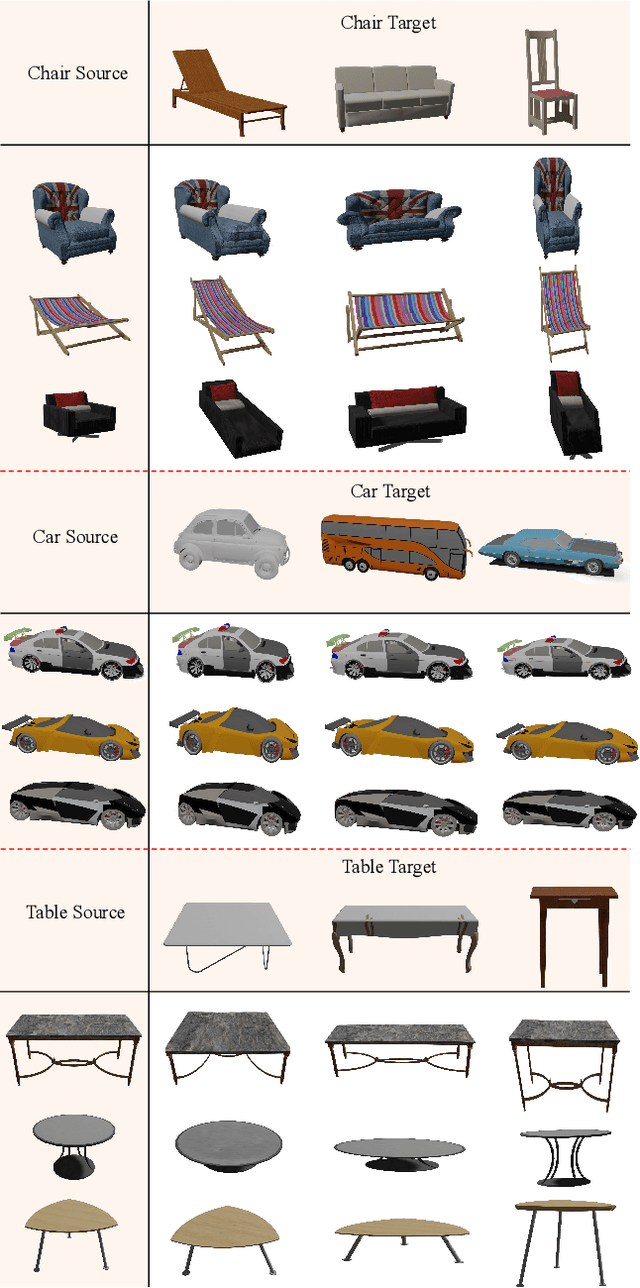
Abstract:As 3D Gaussian Splatting (3DGS) gains popularity as a 3D representation of real scenes, enabling user-friendly deformation to create novel scenes while preserving fine details from the original 3DGS has attracted significant research attention. We introduce CAGE-GS, a cage-based 3DGS deformation method that seamlessly aligns a source 3DGS scene with a user-defined target shape. Our approach learns a deformation cage from the target, which guides the geometric transformation of the source scene. While the cages effectively control structural alignment, preserving the textural appearance of 3DGS remains challenging due to the complexity of covariance parameters. To address this, we employ a Jacobian matrix-based strategy to update the covariance parameters of each Gaussian, ensuring texture fidelity post-deformation. Our method is highly flexible, accommodating various target shape representations, including texts, images, point clouds, meshes and 3DGS models. Extensive experiments and ablation studies on both public datasets and newly proposed scenes demonstrate that our method significantly outperforms existing techniques in both efficiency and deformation quality.
ARAP-GS: Drag-driven As-Rigid-As-Possible 3D Gaussian Splatting Editing with Diffusion Prior
Apr 17, 2025Abstract:Drag-driven editing has become popular among designers for its ability to modify complex geometric structures through simple and intuitive manipulation, allowing users to adjust and reshape content with minimal technical skill. This drag operation has been incorporated into numerous methods to facilitate the editing of 2D images and 3D meshes in design. However, few studies have explored drag-driven editing for the widely-used 3D Gaussian Splatting (3DGS) representation, as deforming 3DGS while preserving shape coherence and visual continuity remains challenging. In this paper, we introduce ARAP-GS, a drag-driven 3DGS editing framework based on As-Rigid-As-Possible (ARAP) deformation. Unlike previous 3DGS editing methods, we are the first to apply ARAP deformation directly to 3D Gaussians, enabling flexible, drag-driven geometric transformations. To preserve scene appearance after deformation, we incorporate an advanced diffusion prior for image super-resolution within our iterative optimization process. This approach enhances visual quality while maintaining multi-view consistency in the edited results. Experiments show that ARAP-GS outperforms current methods across diverse 3D scenes, demonstrating its effectiveness and superiority for drag-driven 3DGS editing. Additionally, our method is highly efficient, requiring only 10 to 20 minutes to edit a scene on a single RTX 3090 GPU.
UniTrans: A Unified Vertical Federated Knowledge Transfer Framework for Enhancing Cross-Hospital Collaboration
Jan 20, 2025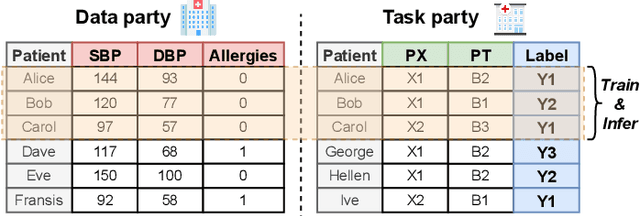

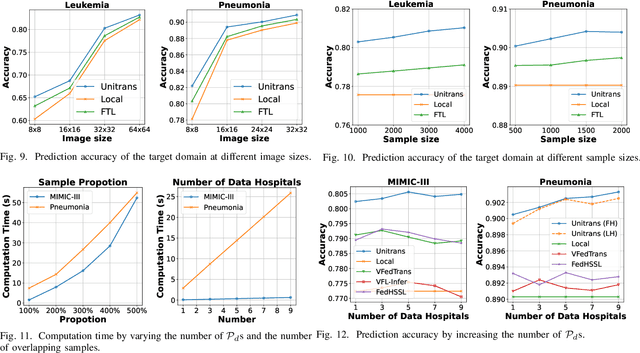
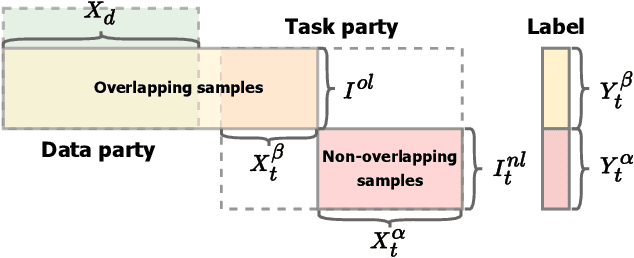
Abstract:Cross-hospital collaboration has the potential to address disparities in medical resources across different regions. However, strict privacy regulations prohibit the direct sharing of sensitive patient information between hospitals. Vertical federated learning (VFL) offers a novel privacy-preserving machine learning paradigm that maximizes data utility across multiple hospitals. Traditional VFL methods, however, primarily benefit patients with overlapping data, leaving vulnerable non-overlapping patients without guaranteed improvements in medical prediction services. While some knowledge transfer techniques can enhance the prediction performance for non-overlapping patients, they fall short in addressing scenarios where overlapping and non-overlapping patients belong to different domains, resulting in challenges such as feature heterogeneity and label heterogeneity. To address these issues, we propose a novel unified vertical federated knowledge transfer framework (Unitrans). Our framework consists of three key steps. First, we extract the federated representation of overlapping patients by employing an effective vertical federated representation learning method to model multi-party joint features online. Next, each hospital learns a local knowledge transfer module offline, enabling the transfer of knowledge from the federated representation of overlapping patients to the enriched representation of local non-overlapping patients in a domain-adaptive manner. Finally, hospitals utilize these enriched local representations to enhance performance across various downstream medical prediction tasks. Experiments on real-world medical datasets validate the framework's dual effectiveness in both intra-domain and cross-domain knowledge transfer. The code of \method is available at \url{https://github.com/Chung-ju/Unitrans}.
Learning Flow Fields in Attention for Controllable Person Image Generation
Dec 12, 2024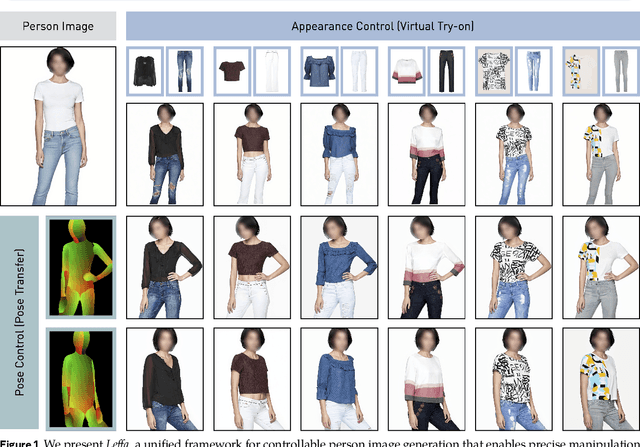
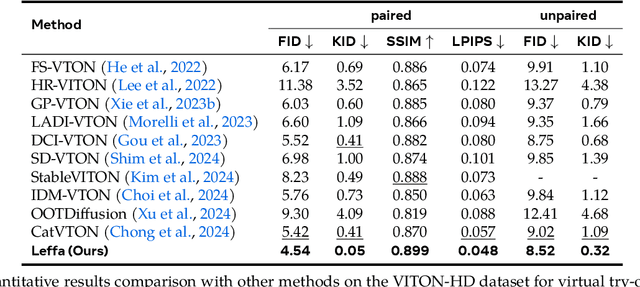
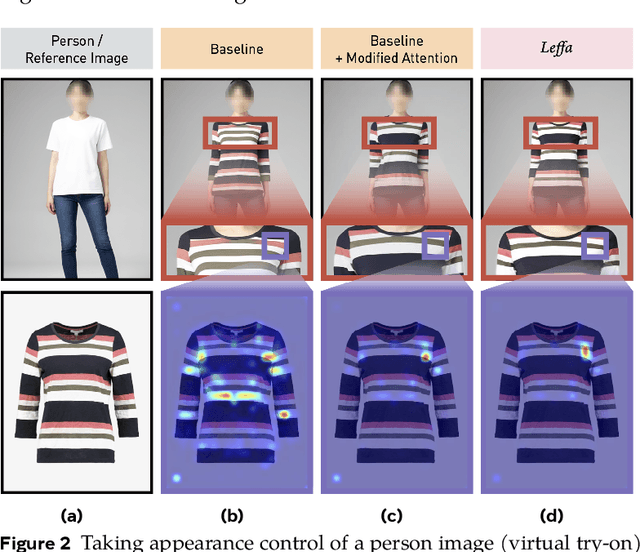

Abstract:Controllable person image generation aims to generate a person image conditioned on reference images, allowing precise control over the person's appearance or pose. However, prior methods often distort fine-grained textural details from the reference image, despite achieving high overall image quality. We attribute these distortions to inadequate attention to corresponding regions in the reference image. To address this, we thereby propose learning flow fields in attention (Leffa), which explicitly guides the target query to attend to the correct reference key in the attention layer during training. Specifically, it is realized via a regularization loss on top of the attention map within a diffusion-based baseline. Our extensive experiments show that Leffa achieves state-of-the-art performance in controlling appearance (virtual try-on) and pose (pose transfer), significantly reducing fine-grained detail distortion while maintaining high image quality. Additionally, we show that our loss is model-agnostic and can be used to improve the performance of other diffusion models.
Stain-aware Domain Alignment for Imbalance Blood Cell Classification
Dec 04, 2024



Abstract:Blood cell identification is critical for hematological analysis as it aids physicians in diagnosing various blood-related diseases. In real-world scenarios, blood cell image datasets often present the issues of domain shift and data imbalance, posing challenges for accurate blood cell identification. To address these issues, we propose a novel blood cell classification method termed SADA via stain-aware domain alignment. The primary objective of this work is to mine domain-invariant features in the presence of domain shifts and data imbalances. To accomplish this objective, we propose a stain-based augmentation approach and a local alignment constraint to learn domain-invariant features. Furthermore, we propose a domain-invariant supervised contrastive learning strategy to capture discriminative features. We decouple the training process into two stages of domain-invariant feature learning and classification training, alleviating the problem of data imbalance. Experiment results on four public blood cell datasets and a private real dataset collected from the Third Affiliated Hospital of Sun Yat-sen University demonstrate that SADA can achieve a new state-of-the-art baseline, which is superior to the existing cutting-edge methods with a big margin. The source code can be available at the URL (\url{https://github.com/AnoK3111/SADA}).
From Machine Learning to Machine Unlearning: Complying with GDPR's Right to be Forgotten while Maintaining Business Value of Predictive Models
Nov 26, 2024Abstract:Recent privacy regulations (e.g., GDPR) grant data subjects the `Right to Be Forgotten' (RTBF) and mandate companies to fulfill data erasure requests from data subjects. However, companies encounter great challenges in complying with the RTBF regulations, particularly when asked to erase specific training data from their well-trained predictive models. While researchers have introduced machine unlearning methods aimed at fast data erasure, these approaches often overlook maintaining model performance (e.g., accuracy), which can lead to financial losses and non-compliance with RTBF obligations. This work develops a holistic machine learning-to-unlearning framework, called Ensemble-based iTerative Information Distillation (ETID), to achieve efficient data erasure while preserving the business value of predictive models. ETID incorporates a new ensemble learning method to build an accurate predictive model that can facilitate handling data erasure requests. ETID also introduces an innovative distillation-based unlearning method tailored to the constructed ensemble model to enable efficient and effective data erasure. Extensive experiments demonstrate that ETID outperforms various state-of-the-art methods and can deliver high-quality unlearned models with efficiency. We also highlight ETID's potential as a crucial tool for fostering a legitimate and thriving market for data and predictive services.
 Add to Chrome
Add to Chrome Add to Firefox
Add to Firefox Add to Edge
Add to Edge